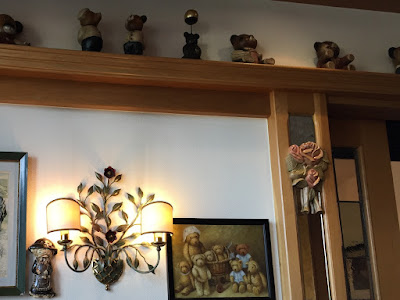 |
| Bernkastel Town Square with Half-Timbered (Fachwerk) Houses |
Instead, we started our day in the Hotel zum Schloss in Zell, having yet another delicious breakfast buffet. This breakfast was with lit candles on our table, and stained glass windows in the background. And the usual assortment of fresh rolls, fruit, cheese, granola, yoghurt, cold cuts, hot breakfast dishes, boiled eggs, and so on. It really was a heaven for breakfast lovers - and we both really love breakfast.
 |
| Breakfast Schloss Zell |
Then we walked through open forests and fields:
When we arrived in Enkirch, it was too early for lunch, so we kept going.
Regrettably, we managed to get a little lost in town. Losing the trail is easier in the villages and towns because there are more side streets where the trail can turn and it's easy to miss a sign that might be hiding on a lamp post, or was possibly removed by some kids.
We stopped and asked three local women who told us to follow the Moselhöhenweg, another long-distance hiking trail in the Mosel region, until it meets the Camino. The Moselhöhenweg led us back up the ridge and for a while, we worried that we wouldn't manage to find the Camino again but eventually we saw the familiar yellow shell.
This part of the Camino led us through vineyards, and occasionally we'd see a vintner driving around on a tractor. We had a good laugh when a tractor raced past us at quite a clip, with a friendly vintner smiling at us, and a California license plate on the back of his trailer!
Most of the ridges along the Mosel have an underlying bedrock of slate. The different kinds of slate cause the wine grown in the derived topsoil to have different flavors. Informative plaques explained the terroirs in the different parts of the Mosel Valley. The German government also runs an experimental station for researching various wine-growing techniques, including techniques that try to limit chemical use. If we had been staying for longer it would have been fun to visit.
We finally arrived in Trabach after 2 pm, not yet at our destination but still in need of a break. We'd already eaten our trail-mix-and-fruit lunch, but after a long and hot hike any town is a good stop for an ice cream, even if you're not at the end of the trail yet. So we stopped at a cafe and had some ice cream and a rest, asked the waiter to fill our water bottles, and started out again for the last piece to Bernkastel.
In Bernkastel, after a long and pretty exhausting day, we were finally greeted by the city gate:
 |
| Bernkastel Town Gate |
After freshening up, we explored the town. Bernkastel has an old town square surrounded with half-timbered houses. We found a restaurant with a great view of the square and had dinner al fresco. We shared a large salad and a salmon dish, then walked around to enjoy the picturesque old houses. Below you can see the Spitzhäuschen (Narrow House), which is really much narrower at the bottom than at the top, and was built in the late 1400s. Bernkastel and Kues, the town on the other side of the river, merged many years ago and now form one community, split by the river but joined by a couple of bridges.
 |
| Spitzhäuschen (Narrow House) in Bernkastel |
After dinner and a stroll, we walked back the half mile or so to the hotel and found that the room was a little warmer than we had expected. The drawback of the great view was that the windows faced west and we therefore got the late afternoon and evening sun. In Germany, no hotels outside of the big international hotels in the major cities have air conditioning, but our room cooled down nicely at night and besides, we were quite tired after the hike: 22 km, with 850 m elevation gain. This was the most strenuous day in terms of elevation gain, and we had no trouble falling asleep when our heads hit the pillow.





